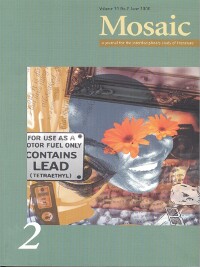Issue 33.2
Overview

General Issue
Published: June 2000
View the issue introduction or see the issue summary and contents below.
9 essays, totalling 192 pages
$15.00 CAD
Central to this issue of Mosaic is the imagetext, a concept put forth by W.J.T. Mitchell. Appropriately, then, this issue opens with an interview of Mitchell, conducted by Christine Wiesenthal and Brad Bucknell. Among the eight essays that follow is a focus on explorations of visual content, including film, photography, art, and visual poetry. These essay focus on the works of Katherine Anne Porter, Marianne Moore, William Blake, Virginia Woolf, and other significant artists.
Essays into the Imagetext: An Interview with W.J.T. MitchellBrad Bucknell and Christine Wiesenthal This is an edited transcript of a two-hour interview with W.J.T. Mitchell, conducted by Christine Wiesenthal (CW) and Brad Bucknell (BB) on March 10, 2000 at the Fort Garry Hotel, Winnipeg, Manitoba. Professor Mitchell delivered the University of Manitoba Sidney Warhaft Memorial Lecture titled “Offending Images: Sensation at the Brooklyn Museum” on March 9, 2000, at the Plug In Gallery, Winnipeg. | |
Paul Eluard and the Origins of Visual SubjectivityJonathan Strauss Issues of subjectivity and vision were central to the dominant French intellectual movements of the 20th century. Through this early lyric practice, Paul Eluard elaborated a model of subjectivity that was grounded in a rhetorically complex visibility to another and that predated other, related formulations by thinkers such as Lacan. | |
Unreeled: A History of Katherine Anne Porter’s Filmic Text, HaciendaRobert Mellin In Hacienda, Porter exploits the linguistic and bibliographical meanings of the physical text in order to negotiate a narrative that represents the variegated cultural landscape of 1920s Mexico. This essay argues that the reader must “see” Hacienda as if it were a film, a reading practice denied by modern publishing practices. | |
The “Ballet Mécanique” of Marianne Moore’s Cinematic ModernismSusan McCabe Contending that modernist poetry and avant-garde film have significant connections, this essay examines Marianne Moore’s poem “Those Various Scalpels” in light of Fernand Léger’s Ballet Mécanique. Through this analysis, the essay explores how both media simultaneously figure forth and fragment the gestural body. | |
Balzac, Frenhofer, Le Chef-d’oeuvre inconnu: Ut Poesis PictureKevin Bongiorni This article challenges traditional readings of Balzac’s Le Chef-d’oeuvre inconnu. Whereas many critics dismiss both the aging painter Frenhofer and his “chef-d’oeuvre” as failures, diverse elements within the text suggest that the failure lies instead with the two lesser painters, Poussin and Porbus, and their inability to comprehend Frenhofer’s attempt to turn painting into poetry. | |
The Medium, the Message and the line in William Blake’s LaocoönJulia M. Wright In this essay, I address Blake’s challenge to formal norms: first, by situating The Laocoön in the context of contemporary debates about media; then by addressing Blake’s critique of linearity in terms of those debates; finally, by sketching some of the reading practices enabled by Blake’s work. | |
“A Thousand Angles”: Photographic Irony in the Work of Julia Margaret Cameron and Virginia WoolfNatasha Aleksiuk This essay argues that both Julia Margaret Cameron and her great-niece Virginia Woolf challenge class and gender stereotypes through photographic irony. Departing from the reading of Cameron as Woolf’s staid Victorian foil, I suggest that Woolf was aware of the destabilizing force of humor within Cameron’s work. | |
Une Machine À Coudre Manuelle: Elizabeth Bishop’s “Everyday Surrealism”Ernesto Suárez Toste An approach to surrealist painting from the point of view of its formal heterogeneity suggests that Elizabeth Bishop’s affinities with this movement can be safely related to the non-automatic branch. Bishop and René Magritte followed an almost identical poetics of defamiliarization, which likely derived from the common influence of Giorgio de Chirico. | |
Musical Dimensions of Prose Narratives: Musikant by André HodeirJean-Louis Pautrot Hodeir, an avant-garde jazz musician in Postwar France, later published fictions entertaining relations to music. I consider Hodeir’s careers, as instrumentalist, musicologist, composer, and his itinerary from music critic to novelist, arguing that his literary aesthetics derives from his musical aesthetics. I also examine Musikant (1987) for its musical dimensions. |